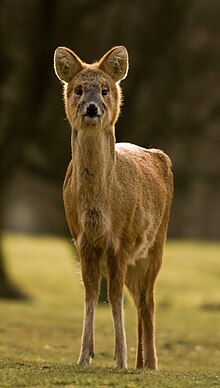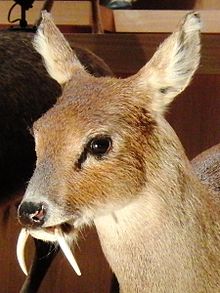Habitat and distribution

Water deer are indigenous to the lower reaches of the Yangtze River, coastal Jiangsu province (Yancheng Coastal Wetlands), and islands of Zhejiang of east-central China, and in Korea, where the demilitarized zone has provided a protected habitat for a large number. They inhabit the land alongside rivers, where they are protected from sight by the tall reeds and rushes. They are also seen on mountains, swamps, grasslands, and even open cultivated fields. Water deer are proficient swimmers, and can swim several miles to reach remote river islands. Chinese Water Deer are now located in United Kingdom, France and Argentina, and even some in the United States.[4][5]
Britain
Chinese water deer (Hydropotes inermis inermis) at the Whipsnade Zoo
The majority of the current population of Chinese water deer in Britain derives from escapees, with the remainder being descended from a number of deliberate releases. Most of these animals still reside close to Woburn Abbey. It appears that the deer’s strong preference for a particular habitat – tall reed and grass areas in rich alluvial deltas - has restricted its potential to colonize further afield. The main area of distribution is from Woburn, east into Cambridgeshire, Norfolk, Suffolk and North Essex, and south towards Whipsnade. There have been small colonies reported in other areas.[citation needed]
The British Deer Society coordinated a survey of wild deer in the United Kingdom between 2005 and 2007 and noted the Chinese water deer as "notably increasing its range" since the last census in 2000.[6]
France
A small population existed in France originating from animals which had escaped an enclosure in 1960 in western France (Haute-Vienne, near Poitiers). The population was reinforced in 1965 and 1970 and species is protected since 1974. Despite efforts to locate the animals with the help of local hunters, there have been no records since the year 2000, and the population is assumed to be extinct.[7]United States
The species is not native, but a few small deer farms in the southeastern United States have successfully bred water deer.[citation needed]Physical attributes
| Body Length | Shoulder Height | Tail Length | Weight |
|---|---|---|---|
| 75–100 cm | 45–55 cm | 6-7.5 cm | 9–14 kg |
| 2.5-3.3 ft | 18-22 in | 2.4-3 in | 20-31 lbs |
The coat is an overall golden brown color, and may be interspersed with black hairs, while the undersides are white. The strongly tapered face is reddish brown or gray in color, and the chin and upper throat are cream colored. The hair is longest on the flanks and rump. In the fall, the summer coat is gradually replaced by a thicker, coarse-haired winter coat that varies from light brown to grayish brown. Neither the head nor the tail poles are well differentiated as in gregarious deer; consequently, this deer's coat is little differentiated. Young are born dark brown with white stripes and spots along their upper torso.[citation needed]
Teeth
The teeth usually erupt in the autumn of the deer’s first year at approximately 6–7 months of age. By early spring the recently erupted tusks reach approximately 50% of their final length. As the tusks develop, the root remains open until the deer is about eighteen months to two years old. When fully grown, only about 60% of the tusk is visible below the gum.[citation needed]
These canines are held loosely in their sockets, with their movement controlled by facial muscles. The buck can draw them backwards out of the way when eating. In aggressive encounters, he thrusts his canines out and draws in his lower lip to pull his teeth closer together. He then presents an impressive two-pronged weapon to rival males. It is due to these teeth that this animal is often referred to as a "vampire deer."[9]
Behavior
Apart from mating during the rutting season, water deer are solitary animals, and males are highly territorial. Each buck marks out his territory with urine and feces. Sometimes a small pit is dug and it is possible that in digging, the male releases scent from the interdigital glands on its feet. The male also scent-marks by holding a thin tree in his mouth behind the upper canines and rubbing his preorbital glands against it. Males may also bite off vegetation to delineate territorial boundaries.[citation needed]Water deer use their tusks for territorial fights and are not related to carnivores. Confrontations between males begin with the animals walking slowly and stiffly towards each other, before turning to walk in parallel 10–20 m / 32–64 ft. apart, to assess one another. At this point, one male may succeed in chasing off his rival, making clicking noises during the pursuit. However, if the conflict is not resolved at the early stage, the bucks will fight. Each would try to wound the other on the head, shoulders, or back, by stabbing or tearing with his upper canines. The fight is ended by the loser, who either lays his head and neck flat on the ground, or turns tail and is chased out of the territory. Numerous long scars and torn ears seen on males indicate that fighting is frequent. The fights are seldom fatal but may leave the loser considerably debilitated. Tufts of hair are most commonly found on the ground in November and December, showing that encounters are heavily concentrated around the rut.[citation needed]
Females do not seem to be territorial outside the breeding season and can be seen in small groups, although individual deer do not appear to be associated; they will disperse separately at any sign of danger. Females show aggression towards each other immediately before and after the birth of their young and will chase other females from their birth territories.[citation needed]
Communication
Water deer are capable of emitting a number of sounds. The main call is a bark, and this has more of a growl tone when compared with the sharper yap of a muntjac. The bark is used as an alarm, and water deer will bark repeatedly at people and at each other for reasons unknown. If challenged during the rut, a buck will emit a clicking sound. It is uncertain how this unique sound is generated, although it is possibly by using its molar teeth. During the rut a buck following a doe will make a weak whistle or squeak. The does emit a soft pheep to call to their fawns, whilst an injured deer will emit a screaming wail.[citation needed]Reproduction
| Gestation Period | Young per Birth | Sexual Maturity | Life Span |
|---|---|---|---|
| 180–210 days | 1-7 | Does: 7–8 months | 10–12 years |
| Commonly 2-5 | Bucks: 5–6 months |
Water deer have been known to produce up to seven young, but two to three is normal for this species, the most prolific of all deer.[citation needed] The doe often gives birth to her spotted young in the open, but they are quickly taken to concealing vegetation, where they will remain most of the time for up to a month. During these first few weeks, fawns come out to play. Once driven from the natal territory in late summer, young deer sometimes continue to associate with each other, later separating to begin their solitary existence.[citation needed]




No comments:
Post a Comment
Note: Only a member of this blog may post a comment.